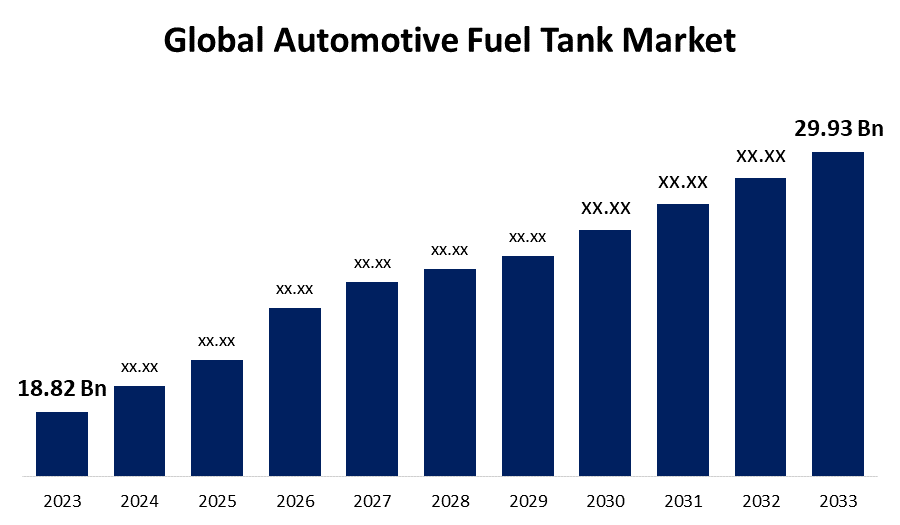Global Automotive Fuel Tank Market Size, Share, and COVID-19 Impact Analysis, By Capacity (Less Than 45 Liters, 45-70 Liters, above 70 Liters), By Material (Aluminum, Plastic, Steel), By Vehicle Type (Passenger Car, Light Commercial Vehicle, Heavy Commercial Vehicle), and By Region (North America, Europe, Asia-Pacific, Latin America, Middle East, and Africa), Analysis and Forecast 2023 - 2033
Industry: Automotive & TransportationGlobal Automotive Fuel Tank Market Insights Forecasts to 2033
- The Global Automotive Fuel Tank Market Size was Valued at USD 18.82 Billion in 2023
- The Market Size is Growing at a CAGR of 4.75% from 2023 to 2033
- The Worldwide Automotive Fuel Tank Market Size is Expected to Reach USD 29.93 Billion by 2033
- North America is Expected to Grow the fastest during the forecast period.

Get more details on this report -
The Global Automotive Fuel Tank Market Size is Anticipated to Exceed USD 29.93 Billion by 2033, Growing at a CAGR of 4.75% from 2023 to 2033.
Market Overview
The increasing need for automobile fuel tanks as vehicle sales increase worldwide is providing a good market outlook. By this, an increased demand for personal transportation options among individuals is driving market expansion. Furthermore, people are looking for convenient and efficient ways to commute from one location to another for work, pleasure, and entertainment. Aside from that, there is an increase in demand for improved automobile fuel tanks as people want cleaner, more fuel-efficient vehicles. Factors such as rising demand for fuel-efficient automobiles, increased vehicle production, and rapid urbanization are likely to drive market expansion. The market is expanding due to increased demand for commercial vehicles, particularly in the logistics and construction industries. The growth of the e-commerce business has fueled this desire. The automotive fuel tank industry is experiencing a surge in demand as the penetration and popularity of electric vehicles grow. To lower vehicle weight and meet rising demand, automakers worldwide are replacing metal gasoline tanks with plastic ones. To decrease air resistance, gasoline tanks must be designed to fit within the vehicle's structure. In line with this, individuals are increasingly choosing automobiles with higher fuel efficiency to lower their carbon impact and promote environmental sustainability.
Report Coverage
This research report categorizes the market for the global automotive fuel tank market based on various segments and regions forecasts revenue growth and analyzes trends in each submarket. The report analyses the key growth drivers, opportunities, and challenges influencing the global automotive fuel tank market. Recent market developments and competitive strategies such as expansion, product launch, and development, partnership, merger, and acquisition have been included to draw the competitive landscape in the market. The report strategically identifies and profiles the key market players and analyses their core competencies in each sub-segment of the global automotive fuel tank market.
Global Automotive Fuel Tank Market Report Coverage
| Report Coverage | Details |
|---|---|
| Base Year: | 2023 |
| Market Size in 2023: | USD 18.82 Billion |
| Forecast Period: | 2023 - 2033 |
| Forecast Period CAGR 2023 - 2033 : | 4.75% |
| 2033 Value Projection: | USD 29.93 |
| Historical Data for: | 2019 - 2022 |
| No. of Pages: | 200 |
| Tables, Charts & Figures: | 110 |
| Segments covered: | By Capacity, By Material, By Vehicle Type, By Region |
| Companies covered:: | Magna International Inc., YAPP Automotive Parts Co. Ltd., SMA Serbatoi S.P.A., Yachiyo Industry Co., Continental AG, Kautex Textron GmbH & Co. KG, TI Automotive Inc., The Plastic Omnium Group, Martinrea International Inc., Unipres Corporation, and Others |
| Pitfalls & Challenges: | Covid 19 Impact Challanges, Future, Growth and Analysis |
Get more details on this report -
Driving Factors
The automobile industry is working to build lightweight vehicles that will minimize fuel emissions while also improving vehicle performance. Automotive OEMs spend a significant amount of money on research to discover and create lightweight materials for manufacturing automotive components to reduce vehicle weight. Recently, the automotive industry has been migrating away from traditional metal tanks and toward plastic tanks. Plastic tanks have been the favored choice of vehicle manufacturers due to their numerous inherent advantages over metal fuel tanks and are increasing popularity in the market. These tanks are made from high-density polyethylene (HDPE). Because of their flexibility, plastic tanks can be tailored to meet the needs of OEMs.
Restraining Factors
People's growing preference for zero-emission automobiles, combined with tight government requirements to reduce fuel emissions and encourage environmentally friendly vehicles, could restrict market growth throughout the projection period. Furthermore, the increase in the number of EVs is expected to limit car sales, reducing market growth in the next few years.
Market Segmentation
The global automotive fuel tank market share is classified into capacity, material, and vehicle type.
- The less than 45 liters segment is expected to hold the largest share of the global automotive fuel tank market during the forecast period.
Based on the capacity, the global automotive fuel tank market is categorized into less than 45 liters, 45-70 liters, and above 70 liters. Among these, the less than 45 liters segment is expected to hold the largest share of the global automotive fuel tank market during the forecast period. The majority of passenger automobiles, including hatchbacks and sedans, have a fuel tank capacity of less than 45 liters. Passenger car sales and production are increasing dramatically around the world as a result of urbanization, high population rates, rising living standards, and advancements in automotive technology. The surge in disposable income is increasing people's desire to buy a new car. Furthermore, the rising trend of low-emission, lightweight, and high-performance automobiles is attracting the younger generation, boosting market expansion.
- The plastic segment is expected to grow at the fastest CAGR during the forecast period.
Based on the material, the global automotive fuel tank market is categorized into aluminum, plastic, and steel. Among these, the plastic segment is expected to grow at the fastest CAGR during the forecast period. Plastic fuel tanks are mostly made of High-Density Polyethylene (HDPE). These tanks are lightweight and easily manufactured to meet OEM standards. Plastic gasoline tanks are in higher demand than metal fuel tanks, which drives up demand for HDPE. Plastic gasoline tanks are used in nearly every vehicle sector, including passenger vehicles, light trucks, and heavy trucks. The need for plastic gasoline tanks is primarily driven by expanding vehicle production and the growing trend of vehicle weight reduction, which has been sparked by rigorous emission standards.
- The passenger car segment is expected to hold a significant share of the global automotive fuel tank market during the forecast period.
Based on the vehicle type, the global automotive fuel tank market is categorized into passenger car, light commercial vehicle, heavy commercial vehicle. Among these, the passenger car segment is expected to hold a significant share of the global automotive fuel tank market during the forecast period. Rising urbanization, more industry, strong growth rates, greater living standards, and an increase in average discretionary income. Automobile manufacturers prioritize the development of lightweight gasoline tank materials to make their passenger cars. For every 100 kilometers travelled, a reduction of up to 100 kg saves between 0.3 and 0.5 liters of gasoline. Lightweight automobiles improve vehicle performance and minimize fuel pollution.
Regional Segment Analysis of the Global Automotive Fuel Tank Market
- North America (U.S., Canada, Mexico)
- Europe (Germany, France, U.K., Italy, Spain, Rest of Europe)
- Asia-Pacific (China, Japan, India, Rest of APAC)
- South America (Brazil and the Rest of South America)
- The Middle East and Africa (UAE, South Africa, Rest of MEA)
Asia Pacific is projected to hold the largest share of the global automotive fuel tank market over the forecast period.

Get more details on this report -
Asia Pacific is projected to hold the largest share of the global automotive fuel tank market over the forecast period. Given the rising demand for passenger vehicles in China, India, Japan, and South Korea, Asia Oceania is the world's largest auto producer. China is the world's largest maker of cars. India's commercial vehicle market has been rapidly expanding and contributes significantly to the national GDP. Furthermore, increasing industrialization and infrastructure development in Asia and Oceania are boosting commercial vehicle growth. Furthermore, automobile manufacture and production are expanding rapidly as a result of foreign direct investment in countries such as Thailand, Malaysia, and Vietnam. As vehicle production increases, so does demand for automotive gasoline tanks across Asia and Oceania.
North America is expected to grow at the fastest CAGR growth of the global automotive fuel tank market during the forecast period. The increased emphasis on developing specialized fuel storage solutions for hydrogen-powered vehicles. Furthermore, tough emissions laws are driving industry expansion. Furthermore, rising public demand for larger vehicles, such as sports utility vehicles (SUVs) and pickup trucks, is driving market expansion.
Competitive Analysis:
The report offers the appropriate analysis of the key organizations/companies involved within the global automotive fuel tank market along with a comparative evaluation primarily based on their product offering, business overviews, geographic presence, enterprise strategies, segment market share, and SWOT analysis. The report also provides an elaborative analysis focusing on the current news and developments of the companies, which includes product development, innovations, joint ventures, partnerships, mergers & acquisitions, strategic alliances, and others. This allows for the evaluation of the overall competition within the market.
List of Key Companies
- Magna International Inc.
- YAPP Automotive Parts Co. Ltd.
- SMA Serbatoi S.P.A.
- Yachiyo Industry Co.
- Continental AG
- Kautex Textron GmbH & Co. KG
- TI Automotive Inc.
- The Plastic Omnium Group
- Martinrea International Inc.
- Unipres Corporation
- Others
Key Market Developments
- In December 2023, Toyota Motor Corporation collaborated with UBE Corporation to create a new type of polyamide 6 resin called UBE NYLON 1218IU. This novel resin is employed as the plastic liner material in the high-pressure hydrogen tank of the new Toyota Crown fuel-cell vehicle (FCV). The nylon 6 resin meets the severe standards for preventing hydrogen leaks in the FCV's high-pressure hydrogen tank.
- In November 2023, Robert Bosch GmbH has introduced H2 Mobility, a new technology that combines a fuel injection system, tank system, exhaust gas treatment system, sensors, and controllers. The technology is outfitted with a variety of components, including an ignition coil, injectors, control unit, rail, DNOX, spark plug, Pr. sensor-EGT, and throttle valve. The company offers H2E technology for long-haul trucks as well as products for a variety of markets such as SUVs, LCVs, coaches, and heavy-duty buses.
Key Target Audience
- Market Players
- Investors
- End-users
- Government Authorities
- Consulting And Research Firm
- Venture capitalists
- Value-Added Resellers (VARs)
Market Segment
This study forecasts revenue at global, regional, and country levels from 2020 to 2033. Spherical Insights has segmented the global automotive fuel tank market based on the below-mentioned segments:
Global Automotive Fuel Tank Market, By Capacity
- Less Than 45 Liters
- 45-70 Liters
- Above 70 Liters
Global Automotive Fuel Tank Market, By Material
- Aluminum
- Plastic
- Steel
Global Automotive Fuel Tank Market, By Vehicle Type
- Passenger Car
- Light Commercial Vehicle
- Heavy Commercial Vehicle
Global Automotive Fuel Tank Market, By Regional
- North America
- US
- Canada
- Mexico
- Europe
- Germany
- UK
- France
- Italy
- Spain
- Russia
- Rest of Europe
- Asia Pacific
- China
- Japan
- India
- South Korea
- Australia
- Rest of Asia Pacific
- South America
- Brazil
- Argentina
- Rest of South America
- Middle East & Africa
- UAE
- Saudi Arabia
- Qatar
- South Africa
- Rest of the Middle East & Africa
Need help to buy this report?